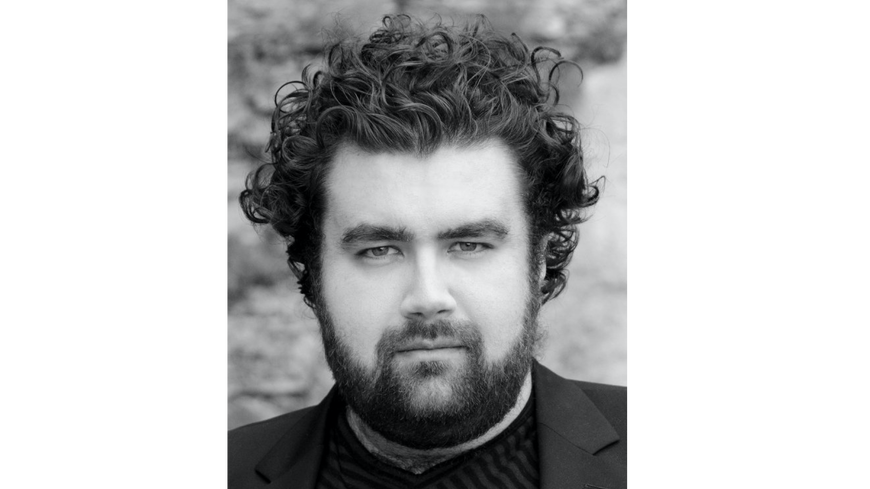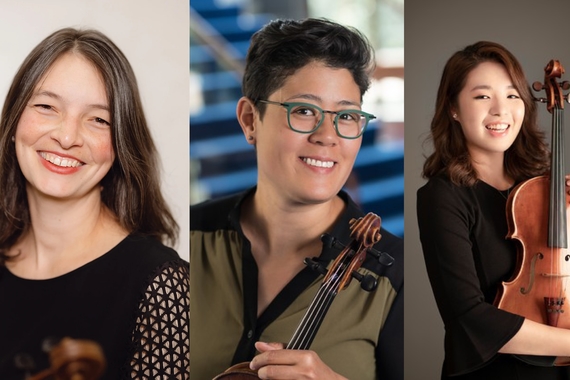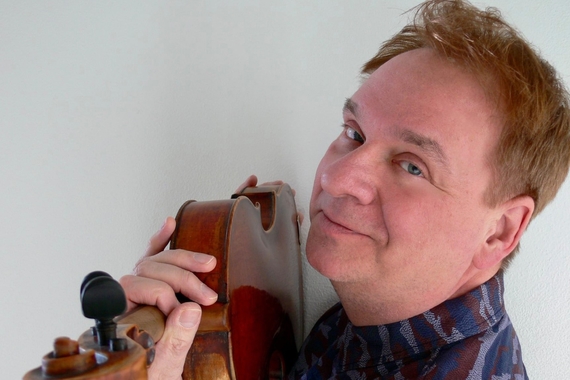Understanding Social Communication and Sound Environments of Past and Present Through the Lens of Musicology
Through the School of Music’s Musicology doctoral program, student Joseph V. Nelson (student of Kelley Harness) has been able to independently shape his interests into academic research subjects. His work primarily focuses on Vocal Intimacy and Queer Identity in the television show Schitt’s Creek, as well as the musical and sonic geography of Covent Garden Market in the Seventeenth-Century. In recent months, he has gained academic notoriety through presenting at various internationally recognized conferences, including the Early Modern Soundscapes, the Society for Musicology, and Music and the Moving Image conferences. We recently spoke with Nelson about his research subjects and presentations.
What led you to pursue musicology studies?
JN: I have always been academically inclined, even back as a freshman voice major. After I completed my master’s degree in vocal performance, I grew tired of the gigging economy endemic to singing professionally and looked for other options as a career in music adjacent to performance. When I contacted Dr. Kelley Harness about the musicology/ethnomusicology program, she invited me to the meeting of the Society of Seventeenth-Century Music that was held at the U of MN that summer and I was hooked. I realized I had found my people and have enjoyed the ride ever since.
What is the most interesting topic you’ve studied so far?
JN: The most interesting topic has been Bethlem Hospital and its connection to mad songs. As probably the most infamous and archetypal of asylums, I’m fascinated by the idea that people went there for treatment but became spectacles for other Londoners who paid to visit the place and spectate among the mad residents. Henry Purcell wrote a famous song, “From Silent Shades, and the Elysian Groves,” which is sung in the voice of Bess of Bedlam and Bess’s counterpart was Poor Tom o’ Bedlam, a figure that became the archetype for vagabonds and mad beggars. Poor Tom also symbolized Bethlem in the minds of many seventeenth-century Londoners. While I took many paths in pursuing my dissertation topic, the asylum still lingers in my head as an important part of the equation in understanding subjects like musical order and disorder, mad songs, and the history of mad scenes in opera. London, after all, has one of the historic opera houses in Covent Garden. And it was there that Handel premiered Orlando with its famous mad scene. Yet, it still remains a bit of a mystery as to what London audiences in the eighteenth century thought of Orlando’s madness, especially given that many of them had likely visited Bethlem and paid to spectate among the mad residents. If “bedlam” became synonymous with chaotic and sometimes dangerous situations, then what did it mean to one of Handel’s patrons when they saw Orlando sing “Ah! stigie larve…Vaghe pupille”? I would suggest that at least sometimes the specter of the asylum came to mind when those scenes and arias appeared on the stage.
What are your main areas of research? What do you find to be the most surprising or fun aspect of this research?
JN: My dissertation investigates the politics of noise through the relationship between mad songs, the sonic landscape of Bethlem Hospital, and social and political disorder in seventeenth-century London. My principal case study came from running across references to Poor Tom o’ Bedlam, or Mad Tom, and from there I explored a range of issues from gender and sexuality to Stuart court masques, morris dancing, folk and country music in popular ballads, Shakespeare’s King Lear, and the medical practices of the infamous Bethlem asylum. One of the most enjoyable aspects of my research has been exploring the geography of early modern London and everyday life in the city through maps and first-hand accounts. Scholars and archivists have digitized an extraordinary amount of material from that time and created online resources that provide platforms where maps and text sources interact to tell the story of real people living and working in the city. The Map of Early Modern London project, for example, has been incredibly useful and fun. Scholars who work on more modern topics are often blown away when I put that site up on the screen during presentations and use the pop-up texts regarding this or that section of the city that I selected to show passages from John Stow’s Survey of London.
Why do you believe the eighteenth-century musical and sonic geography of the London Covent Market is important to study?
JN: Music has been a defining characteristic of Covent Garden for centuries, especially given the presence of the opera house. Yet, one of the things I think a lot of people get wrong is thinking that the music of elite audiences, what we call “classical music” and opera, was not the Top 40 popular music of its day nor the music most people heard in their everyday life. Yet, people who did not have access to elite spaces such as the royal court or aristocratic salons still played music and listened to others perform. Trying to recover some sense of the street culture and music then can greatly expand how we see eighteenth-century music in one of Europe’s cultural capitals. Additionally, an important strategy for what we’re calling “decolonizing” the music curriculum, I feel, is to incorporate more folk/traditional and popular musics from earlier periods into our music history courses as these vernacular musics often say more about the attitudes and culture they come from than elite music. While this will never displace Bach or Handel, important composers whose music I love and have performed, bringing vernacular musics into the classroom opens things up to marginalized groups, such as the 10,000+ free black people living in London by the late 18th century or subjugated Irish immigrant workers. Street performers would have been one of the groups playing this music and one of the main ways Londoners heard music in their daily life. Covent Garden Market had to have seen a steady flow of such performers, much as it does today. Thus, I feel there’s a blaring hole in the history of the musical life of that place by not fully investigating the stories of those performers and striving to understand how they helped shape musical and cultural life in the city.
How did you choose Schitt’s Creek as a program to analyze? Can you tell us more about that research process?
JN: Like many people, I binged Schitt’s Creek during the early months of the pandemic and one of the things I noticed was the prominent role of music in that series. Besides the memorable scenes where Patrick serenades David, there is the Cabaret episode and various musical scenes by Catherine O’Hara’s brilliant character Moira. However, Noah Reid’s performance as Patrick had a particular vocality that seemed very fitting to his character, with his choice of timbre and vocal inflection adding to the intimacy in his performance of “Simply the Best.” My secondary area of research lies in popular music and queer masculinities, so I was fascinated by the idea of how we use timbre to communicate a sense of intimacy and emotional vulnerability. Then I set about trying to gather as much relevant scholarship on the relationship between gender and singing in popular music, while listening to those musical scenes over and over and checking out the albums Reid has released outside of the show. I then compared his singing to his timbre and vocal inflection during intimate conversations between him and David. I’m sure there’s a whole body of research out there in fields like Psychology or Linguistics on how we speak to people during intimate moments with loved ones. But probably the most enduring type of music in all of history has been singing to or about romantic love and intimate partners. I have not found much scholarship on that yet and so this paper was a way to tap into that subject and put out some initial theories.
What were you most excited about presenting at your conferences?
JN: I was most excited about having scholars from all over the world hear my work. These conferences have passed by the time this comes out, but one of the silver linings of this terrible pandemic was the many conferences that went virtual. As disorienting and unsatisfying as the virtual experience has been compared to in-person conferences, it allowed many people to attend who, for one reason or another, couldn’t do so before. That made it a perfect time to apply for every conference where I could present my research. Besides the personal benefit of networking and building my scholarly profile, I also enjoyed representing the University of Minnesota and School of Music at conferences where most attendees have never heard of us, particularly at European conferences. I have colleagues who do incredible work and we have great faculty, so having the opportunity to present at a conference alongside graduate students from Oxford and Cambridge and hold my own feels really good. And during a year when I was struggling to finish revising my dissertation and when the whole world has suffered under this pandemic, it has been a blessing to have these conferences to motivate me, help me refine my research, and connect with the communities of scholars outside of the Twin Cities.
What is one thing you hope the audience takes away from each of your presentations?
JN: The main thing is that I hope to build my scholarly profile and get my name out into the world. These papers centered on very different topics and I hope they demonstrate my skills and knowledge in each of those areas so that people see me as a fully developed and capable scholar. The common characteristic between the two papers, though, remains my curiosity about how people interact through music and how it impacts our intimate and everyday lives. Music affects our relationships to friends, family, romantic partners, and to the world around us. It is an important part of our community and ethnic identities. But on the micro-level of one-on-one interactions, music can sometimes fade into the background or purposely serve as background noise. Yet that means we experience music at moments that have meaningful impacts on our lives and who we become. So I hope I get somewhere in the ballpark of communicating that in these papers.



